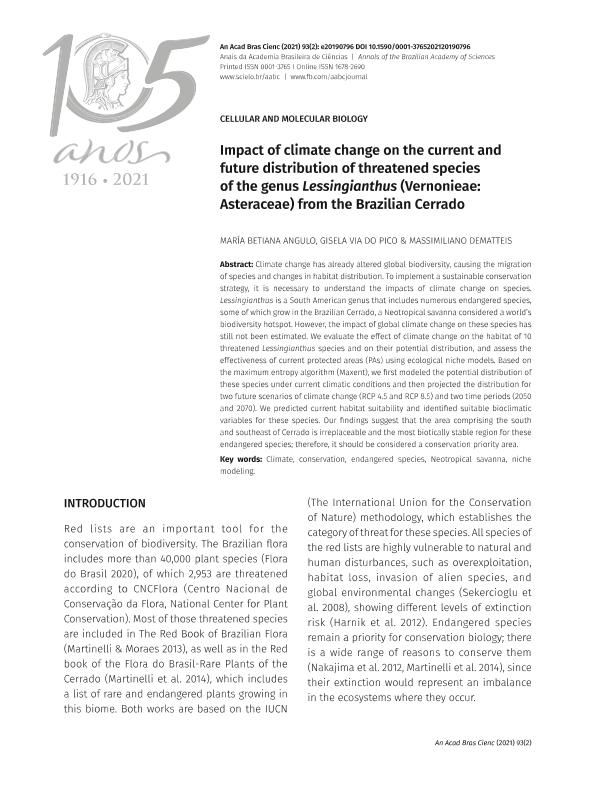Artículo
Impact of climate change on the current and future distribution of threatened species of the genus Lessingianthus (Vernonieae: Asteraceae) from the Brazilian Cerrado
Fecha de publicación:
03/2021
Editorial:
Academia Brasileira de Ciencias
Revista:
Anais da Academia Brasileira de Ciencias
ISSN:
0001-3765
e-ISSN:
1678-2690
Idioma:
Inglés
Tipo de recurso:
Artículo publicado
Clasificación temática:
Resumen
Climate change has already altered global biodiversity, causing the migration of species and changes in habitat distribution. To implement a sustainable conservation strategy, it is necessary to understand the impacts of climate change on species. Lessingianthus is a South American genus that includes numerous endangered species, some of which grow in the Brazilian Cerrado, a Neotropical savanna considered a world’s biodiversity hotspot. However, the impact of global climate change on these species has still not been estimated. We evaluate the effect of climate change on the habitat of 10 threatened Lessingianthus species and on their potential distribution, and assess the effectiveness of current protected areas (PAs) using ecological niche models. Based on the maximum entropy algorithm (Maxent), we first modeled the potential distribution of these species under current climatic conditions and then projected the distribution for two future scenarios of climate change (RCP 4.5 and RCP 8.5) and two time periods (2050 and 2070). We predicted current habitat suitability and identified suitable bioclimatic variables for these species. Our findings suggest that the area comprising the south and southeast of Cerrado is irreplaceable and the most biotically stable region for these endangered species; therefore, it should be considered a conservation priority area.
Palabras clave:
CLIMATE
,
CONSERVATION
,
ENDANGERED SPECIES
,
NEOTROPICAL SAVANNA
,
NICHE MODELING
Archivos asociados
Licencia
Identificadores
Colecciones
Articulos(IBONE)
Articulos de INST.DE BOTANICA DEL NORDESTE (I)
Articulos de INST.DE BOTANICA DEL NORDESTE (I)
Citación
Via Do Pico, Gisela Mariel; Angulo, Maria Betiana; Dematteis, Massimiliano; Impact of climate change on the current and future distribution of threatened species of the genus Lessingianthus (Vernonieae: Asteraceae) from the Brazilian Cerrado; Academia Brasileira de Ciencias; Anais da Academia Brasileira de Ciencias; 93; 2; 3-2021; 1-16
Compartir
Altmétricas




